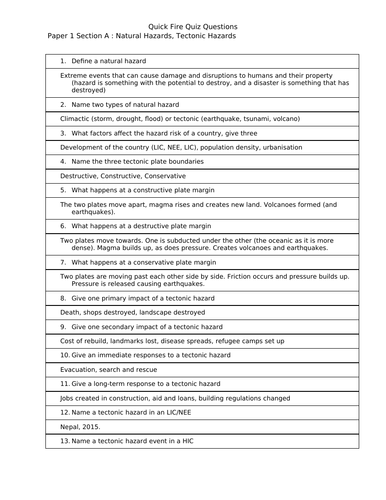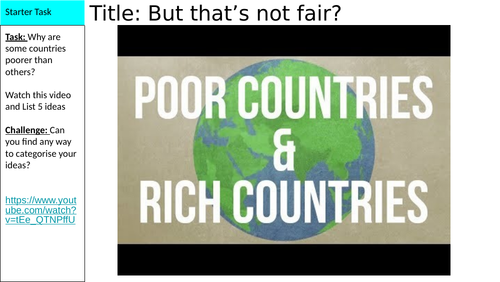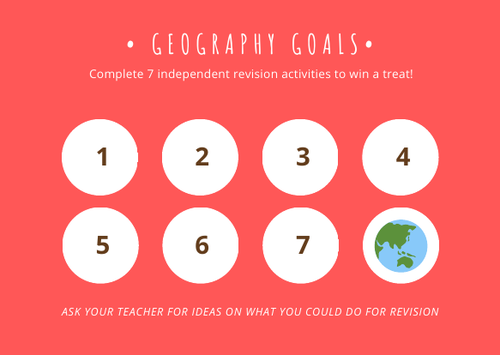
30Uploads
16k+Views
5k+Downloads
All resources

Dharavi Slum Settlement Mumbai
This lesson introduces the opportunities and challenges of the Dharavi slum settlement in Mumbai. It is within the topic of urbanisation. The tasks include sketching and annotating the slum area using a couple of pictures as prompts. It builds towards answering a 6 mark question at the end ‘Compare the opportunities and challenges faced by rural-urban migrants in Mumbai (6)’. This final question is differentiated with a fill in the blanks, scentence starters, and glossary version of the activity.
Activities:
Starter based on an image
Discussion of images
Discussion of social, economic, environmental challenges and opportunities
Sketching
Annotation of the sketch
Answering a 6 mark GCSE style Question

Hurricane Milton Case Study Worksheet (with DME)
This is a differentiated worksheet where students use a range of sources to answer questions including a desision making task. The questions have been designed using command words from AQA GCSE geography, however it could be adapted for any exam board’s command words.
Differentiation: The first page is a worksheet with ‘take it further’ more challenging questions, and the second page just has the main questions with hints on which sources to use, as well as a brief hint for how to answer the descision making task.
The worksheet could be used as homework or as part of a lesson on Hurricane Milton. You may want to provide more sources e.g. a news channel video and a couple more images on the social, environmental and economic impacts. You could also consider supplying resources e.g. a Textbook and an Atlas to allow the students to answer the questions in more depth.

Megacity Shanghai
This lesson introduces megacities to the students. They then categorise some of the features of Shanghai into economic, social and environmental. The students then discuss the challengs of the city and rank them in order.
This lesson works well with Year 8 or any KS3 class.
There is a challenge for each task, for those students who want to take it further!

Quick Fire GCSE Revision Questions: Tectonic Hazards
This is a worksheet that I use as a ‘quickfire quiz’ with my students to jog their memories on the basic and critical facts needed for this module.
One strategy that works well is the following
Give them the questions, and 10 minutes to see how many they can answer
Give them the answer sheet, and anything they got wrong or missed out they should write down in a different colour
Give them a fresh set of questions, and see if they can get 100% this time
The worksheet could be printed with spaces for children to write the answers, used digitally, or used as a template for the kids to write their own flash cards.
There is also an answer sheet attached.

Coasts Knowledge Organiser/ Revision Sheet
This is a colourful and fun resource that could be used as a revision sheet, or as basic information summarised for students to refer back to throughout a teaching unit on coasts.
The information is really condensed so that it includes many aspects of coasts on one A4 sheet of paper.
It includes definitions, wave types, erosion types, weathering, erosional and depositional landforms as well as notes on beach management and long-shore drift.
I use this with my KS3 clasess, and occasionally with KS4 to provide basic and condensed revision material for them to work from.
If you were to use it with KS4 it would work with the AQA Unit 1 Coasts topic.

Global impacts of climate change
Two complete lessons on the impacts of climate change across the world.
Fits with AQA GCSE Paper 1 Section A: The challenge of natural hazards (Climate Change)
I have used with KS3 and KS4
The first lesson covers rising temperatures, warming oceans, sea level rise, increase in frequency and intensity of storms, ocean acidification and desertification.
The second lesson includes spread of disease, changes in farming, drought, hosepipe bans, sea level rise, spread of malaria and changes for scottish ski resorts. It also has individual case studies from certain countries including Nepal and Kenya.
Includes differentiated acitivities.

Globalisation Knowledge Organiser
Globalisation description
This is a fun and colourful knowledge organsier that can be used for revision or to support teaching.
It covers the critical content for a unit on globalisation, particularly good for KS3 although I have used to support teaching in KS4 lessons occasionally when basic knowlegde needs revisiting.
It would also work well with retrieval practice activities!
The information is concise and summarised, and covers the following topics:
Key definitions
Causes of globalisation
Impacts positive and negative
A case study of Nike and its impacts on the host country and country of origin
I hope you enjoy.

Challenges and opportunities in the Thar Desert
This lesson uses the Thar Desert as a case study to investigat e the opportunities and challegnes of the Hot Desert, however most of the materials could be adapted to another case study if your school uses another one.
The lesson starts with locating the Thar desert, then the students use flash cards to fill out a table with Partner A looking into opportunities and Partner B challenges. They then work together sharing their knowledge to complete a matrix. The final task asks students to create a tweet to show their knowedge. This works well for KS3 however for KS4 it could also be replaced with an example GCSE question from zour exam board on opportunities and challenges.
Included Resources
Full lesson Powerpoint
Worksheet for the lesson
Partner A and Partner B table worksheet (differentiated versions of the table also included).
Flash cards of opportunities and challenges
Stretch and challenge task (The Whatsapp task at the end)

Natural causes of climate change
For use with KS3 or KS4.
Fits with AQA Geography Paper 1 Section A (the challenge of natural hazards) Climate Change.
This lesson covers the natural causes of climate change including volcanism, solar variation and orbital changes.
It includes a complete lesson on a powerpoint , information flash cards on the natural causes, and an orbital cycles note taking sheet.
There is a GCSE style question 6. On slide 7 there are scentance starters, a fill in the blanks and key words to be used to differentiate the 6 mark question.

Evidence for climate change lesson
This is a whole lesson with an accompanying activity sheet. It covers the main evidence for climate change (ice cores, tree rings, historical reords).
There is a differentiated activity on slide 10 and 11 with different ways to answer a 6 mark GCSE style question. It encourages students to think about the advantages and disadvantages of each type of evidence.
It links into the AQA Paper 1 specification for AQA GCSE Geography.

Causes of uneven development
This lesson focuses on the causes of uneven development: physical, economic and historical.
This is the structure:
Starter: a video to get the students thinking
Activity 1: Mind map where the students can show what they already know
Activity 2: Filling in a table using the flash cards, on the main reasons for inequality
Activity 3: Short explanation and flow diagram about the multiplier effect
Main task: students annotate satirical cartoons to explain the meaning behind them, using what they have learned
Plenary: Students discuss their interpretations

Climate change Knowledge Organiser / Revision Sheet
This is a fun and colourful knowledge organsier that can be used for revision or to support teaching.
It covers the critical content for a unit on climate change, particularly good for KS3 although I have used to support teaching in KS4 lessons occasionally when basic knowlegde needs revisiting.
It would also work well with retrieval practice activities!
The information is concise and summarised, and covers the following topics:
Greenhouse gas effect
Evidence to show climate change (tree-rings etc.)
Impacts of climate change
Mitigation and adaptation of climate change
Brief mention of impacts in Bangladesh (LIC) and the UK (HIC)
I hope you enjoy.

Population Knowledge Organiser
This is a revision sheet for the topic of population. I use this with KS3 as a revision sheet at the end of the topic, or I give it to them at the beginning so they can see what we will be covering.
The topics on the sheet include:
Causes of population growth
Birth rates
Death rates
Sparse and dense populations
Life expectancy
Urban areas and rural areas
Measures of development
Impacts of population growth

Mitigating climate change
This lesson covers the mitigation strategies for climate change.
It fits with the AQA Paper 1 Climate Change unit. I have used this with KS3 and KS4.
It focuses on CCS, planting trees, renewable energy sources and international agreements.
There are some youtube links and a table to complete.

Changing Economic World: Development Lesson Series
This is a series of 8 fantastic lessons on the Changing Economic World unit of the AQA Geography GCSE. It focuses on the first part of this unit, all about development and the development gap.
I have used this with Year 10, but it would work well for any KS4 class. I hope you enjoy!

Push and pull factors for urbanisation
This lesson introduces push and pull factors, and then uses the example of Lagos to demonstrate it.
I use this lesson with year 8 - but it could be used at any point in KS3.

Nuclear Power Station Hinkley Point Stakeholder Debate
This is a lesson I used with year 10 as a stake holder debate over the issue of Hinkley Point C.
The lesson starts with a cartoon about nuclear power allowing students to relfect on the different perspectives.
Then you will need to create groups for the four stakeholders.
Local Family
Stop Hinkley! Campaign
EDF
UK Government
They have sources to look at, to come up with a one minute speech for the debate.
The lesson ends in a relfection excercise where students place the arguments they heard on a balancing scale. This way they can reflect on the strength of the arguments from different stakeholders.

Geography GCSE knowledge organiser AQA Living with the physical environment
A set of knowledge organisers covering the content for AQA GCSE Geography 9-1 Unit 1.
They have very condensed notes that can be used for revision or to support teaching.
Topics covered include:
Tectonic hazards
Weather hazards
Climate change
Tropical rainforests
Hot deserts
Coastal landscapes
River landscapes

Management of hazards
Powerpoint and resources on the management of natural hazards
For AQA Geography Natural Hazards Unit
Differentiated tasks

Geography Revision Loyalty Card
I give these loyalty cards out to encourage self directed revision before exams or class tests. The students must show me a revision activity they have completed (either something I gave them, or something they have decided on themselves e.g. a mindmap or a case study fact file, timeine, or flashcards). Then I sign the space or use a stamp. Once complete they can choose a reward!
P.s. I got them ordered in busniess card size. They looked great!




















